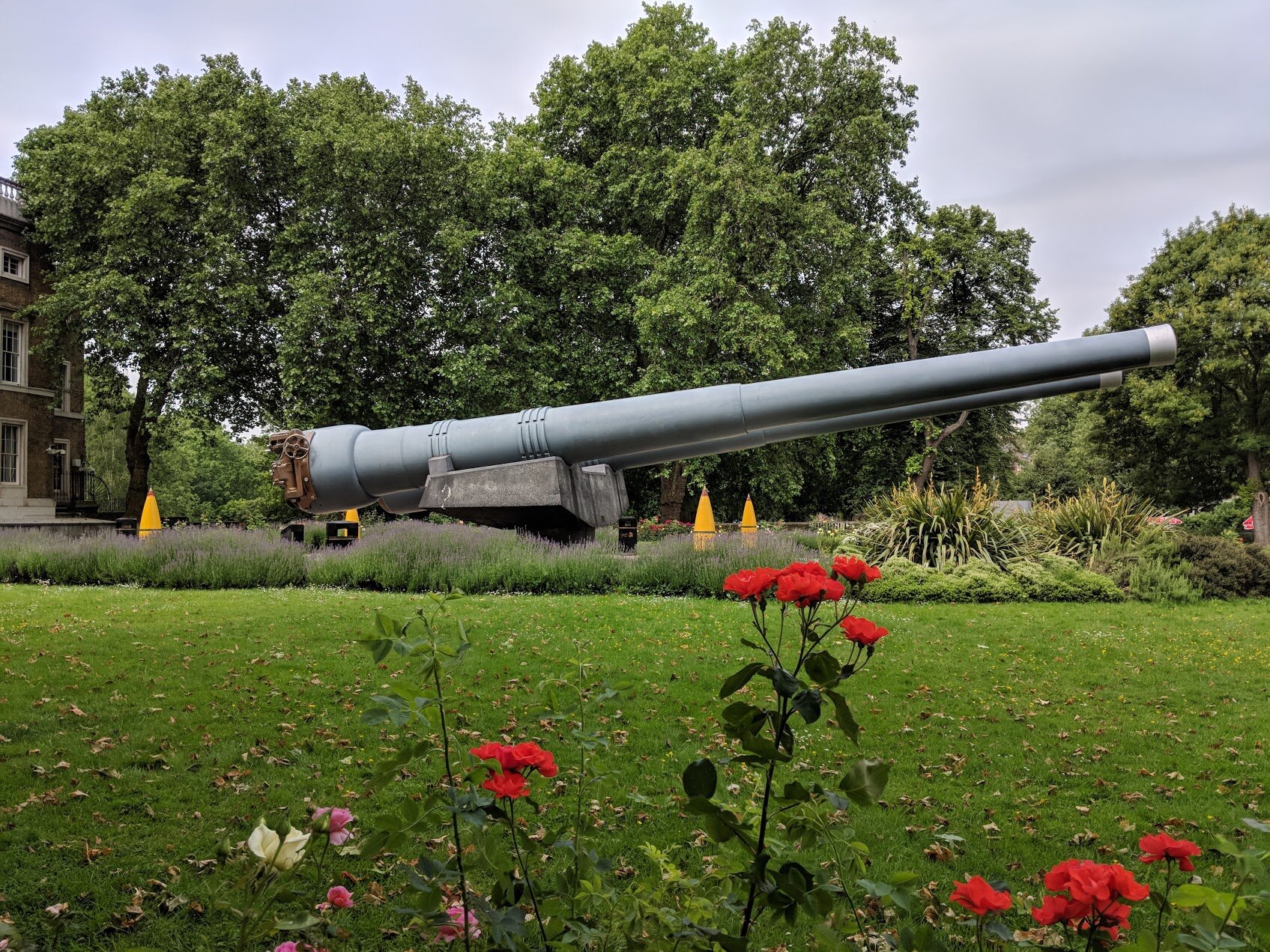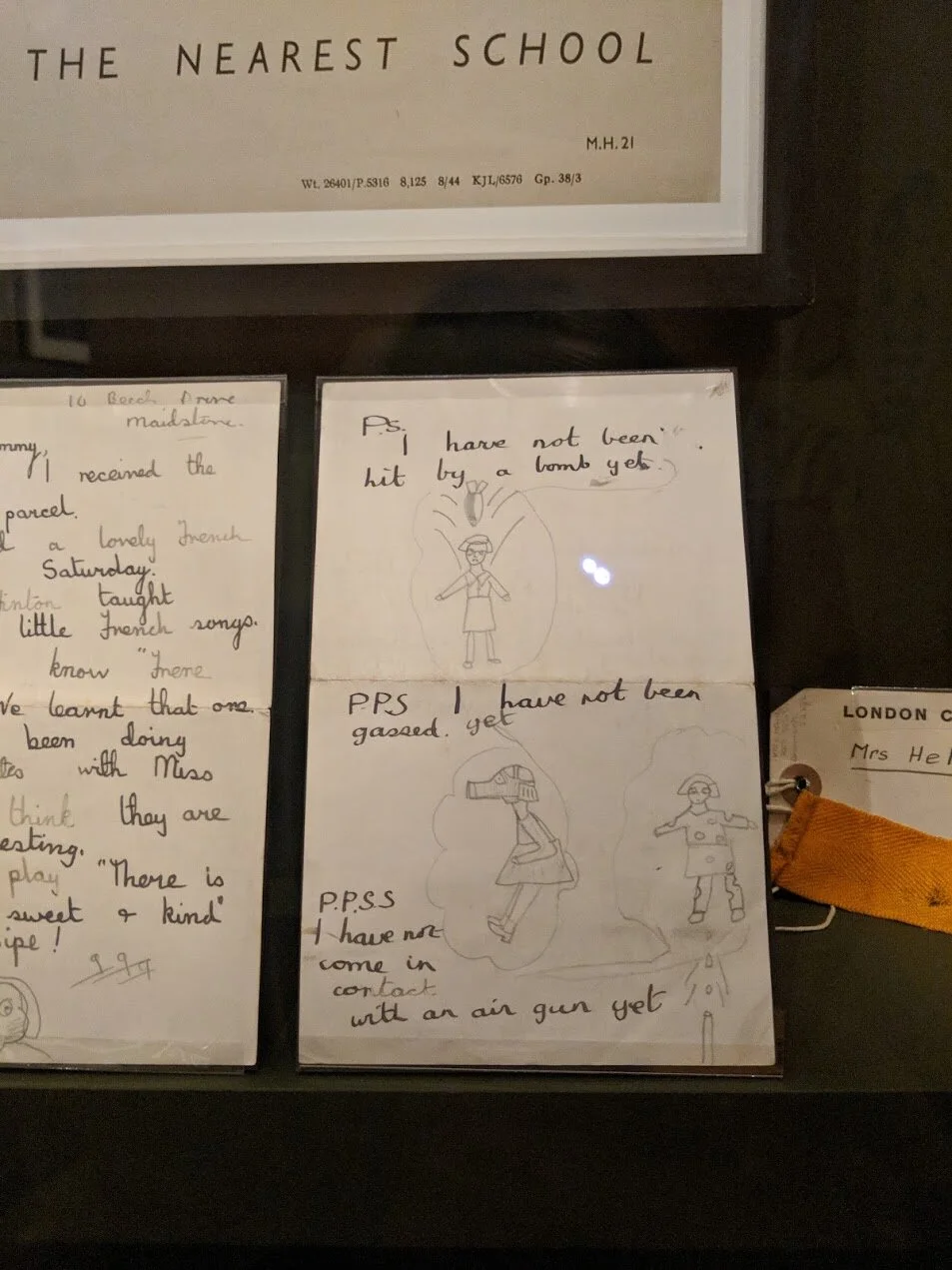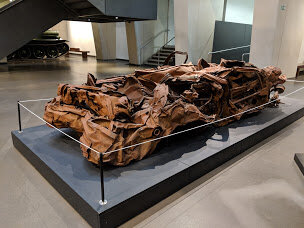On the last full-day of my London vacation, I visited The Imperial War Museum. The Imperial War Museum was absolutely amazing and next to The Churchill War Rooms, it was the best place that I’ve visited in London.
More on that in a minute…remember how I mentioned getting lost in London? Well, my GPS continued to fail me and I had an ordeal as I tried to find The Imperial War Museum.
Luckily, London is full of these handy street maps, which is the only reason that I didn’t resort to buying a map from a tourist shop.
I estimate that I walked about two miles out of my way and really should have taken “The Tube” to the Waterloo Station, however getting lost led to some cool discoveries, such as this class British phone box- which are not so common these days.
And this old monument with a new skyscraper in the background. London is a city of modern and vintage.
Nearer to the museum, I found a school with a scary amount of barb wire! What the heck is going on here?
The Imperial War Museum is located on the outskirts of London, in a semi-residential neighborhood. When I walked back to the tube (Waterloo station) I realized that it was about a mile walk. It isn’t a long distance, if you’re in shape, but for older visitors or those who don’t wish to walk, I recommend a taxi from the tube station. The museum has a convenient taxi rink, located just outside of the main entrance.
The Imperial War Museum knows how to make a great first impression. It has an expansive lawn with old cannons and even a piece from the Berlin Wall.
As with many of the other London museums, The Imperial War Museum has free admission. However, they also would love donations. In exchange for a small donation ( I believe it was 10-15 pounds), I received a blue Imperial War Museum tote bag and a map of the museum.
When I bought my admission ticket, I asked, primarily out of curiosity, how long people typically spend at the museum. The answer was two hours.
HA!!!!!!!
The museum has five floors of exhibits. I started on the first floor, which is dedicated to WW1. I spent over four hours just on the first floor.
I actually toured half of the WW1 exhibit, when I heard an announcement regarding tickets for a guided tour. I left in the middle of WW1 and went to the information desk to inquire. The special tour was ten pounds and lasted for an hour. It was worth far more than the cost of the tickets, truly a must-do, especially since the museum is free.
For the tour, we were provided with headsets, so that we could hear our guide and he didn’t have to shout or disturb other visitors. Only eight people were in my group, which is a real shame, since this added so much to my experience at the museum. I love in-depth looks at specific things.
We were taken around the museum to about six different exhibits and given a greater understanding of their significance. One of the exhibits was a boat used in the Dunkirk evacuation and although I have not watched the film, it was explained to us that the movie, Dunkirk, had many inaccuracies. Another item, was a cage like structure that British families were given to protect themselves during bombings. The guide took the time to answer questions and we had one senior citizen in our group, who added insight from childhood memories of WW2.
After the tour, I went back to WW1 and finished the section. At this point, I was quite overloaded with information and if I had more days in my trip, I would have come back and done the other sections with a fresh mind, but I didn’t have the luxury of time.
I took a quick lunch break in the museum’s cafeteria. One of the things that the Brits really get right foodwise, is lunch. I adore British pre-made sandwiches, crisps, and cloudy lemonade. Even when I had flights that were quickly passing through Heathrow, I grabbed this combo at Boots or M&S. The museum cafeteria was a huge step-up from Boots or M&S, with regard to both quality and price. If sandwiches are not your thing, the museum offered quite a few hot lunch items as well.
After a speedy lunch break, I headed to WW2. I was conscious of time and did not go through the second floor on as leisurely a pace, as I did on the first. I had theatre tickets and I was meeting my niece in central London, so I could not stay until museum closing at six. I only had until about 5pm. I knew that time was precious and that I wouldn’t see it all, so I zeroed in on WW2 and a separate Holocaust exhibition.
Again, just as with the first floor, it would be easy to spend four plus hours on each floor. I felt overwhelmed and frustrated. One of my favorite exhibits in the WW2 section, was look into the life of an average London family, showing how the war impacted each member.
There was a section on English children who were evacuated out of the city and into the countryside. This happened to my mother-in-law, who was sent to Wales during the war. Take a look at this heartbreaking and disturbing letter that an evacuated child wrote.
Speaking of my mother-in-law, I got a kick out of the nutritional signs, especially “Doctor Carrot.” I had been staying with my mother-in-law prior to heading to London and she got a ton of carrots in her weekly farmer’s box, so I felt like I was eating or rather, being offered carrots, non-stop for nearly a week. I even had an inside joke about it with my sister-in-law, who was also offered carrots!
The floor dedicated to The Holocaust was an emotional experience. I’m relieved to report that I was surrounded by respectful and reverent visitors, who quietly viewed the exhibits and refrained from taking photographs. The exhibit is filled with personal items from prisoners, such as a doll that was created from camp uniforms. There are so many horrific personal stories and even stories that show humanity in the darkest of places. One of the main parts of the exhibit is a forty-foot scale model of Auschwitz- Birkenau. If you only have a few hours to tour The Imperial War Museum, you should head to this exhibit first. It’s too important to be missed.
I ended my day with a quick trip to the gift shop and a look at the exhibits in the lobby. Airplanes are suspended from the ceiling and the bottom floor has some large scale exhibits, such an old horse drawn cannon cart and a car that was recently bombed by terrorists. The car is a startling reminder that although the museum deals primarily with wars of the past, the threat is always looming. The world remains an unstable place.
The next time I have a few free-days in London, I will definitely head back to The Imperial War Museum. This is one of the best history museums that I have ever visited and must-see for history buffs. It’s an important place to take children and your visit should not be rushed.
One last, non-related item…as I headed to Trafalgar Square to meet my niece, I bumped into a statue that was on my must-see list. It is called A Conversation with Oscar Wilde 1854-1900 and was one of the literary monuments that I was hoping to visit. I thought it was fitting to have discovered it while on my way to the theatre!





















